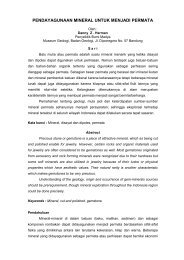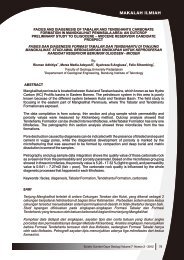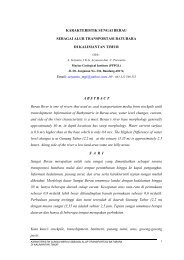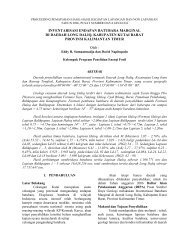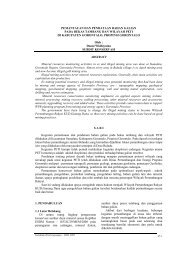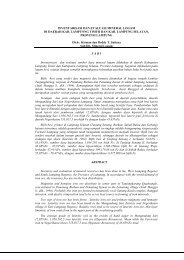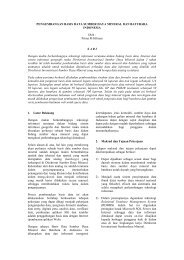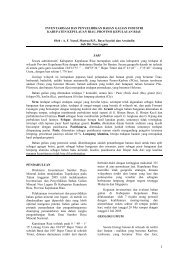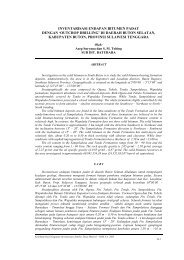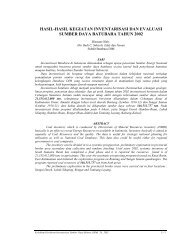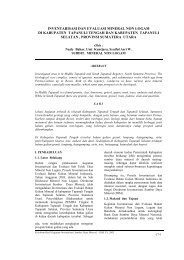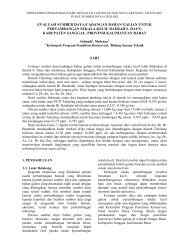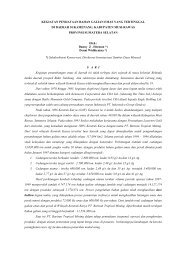comparative petrography of ombilin and bayah coals related ... - ESDM
comparative petrography of ombilin and bayah coals related ... - ESDM
comparative petrography of ombilin and bayah coals related ... - ESDM
Create successful ePaper yourself
Turn your PDF publications into a flip-book with our unique Google optimized e-Paper software.
COMPARATIVE PETROGRAPHY OF OMBILIN AND BAYAH COALS<br />
RELATED TO THEIR ORIGIN<br />
ABSTRACT<br />
Binarko Santoso <strong>and</strong> Bukin Daulay<br />
R&D Centre for Mineral <strong>and</strong> Coal Technology<br />
Jalan Jenderal Sudirman 623 B<strong>and</strong>ung 40211<br />
Ph. 022-6030483, fax. 022-6003373, E-mail: binarkos@tekmira.esdm.go.id<br />
Two coalfields have been contrasted <strong>and</strong> compared on the basis <strong>of</strong> qualitative <strong>and</strong> quantitative studies <strong>of</strong> macerals <strong>and</strong><br />
minerals. The petrological comparison <strong>of</strong> the <strong>coals</strong> indicates that the vitrinite <strong>and</strong> liptinite contents <strong>of</strong> the Ombilin coal<br />
are higher than those <strong>of</strong> the Bayah coal. The inertinite content <strong>of</strong> both <strong>coals</strong> is somewhat similar. The mineral matter <strong>of</strong><br />
the Bayah coal is higher than the Ombilin coal. The vitrinite reflectance <strong>and</strong> rank <strong>of</strong> the Ombilin coal is higher <strong>and</strong> thus,<br />
its coal rank (sub-bituminous to anthracite) is better than that <strong>of</strong> the Bayah coal (sub-bituminous to medium volatile<br />
bituminous).<br />
A clear distinction between the Ombilin <strong>and</strong> Bayah <strong>coals</strong> is not possible with petrographic methods alone, <strong>and</strong> other<br />
geological parameters have to be considered. The maceral compositions <strong>of</strong> the Ombilin <strong>and</strong> Bayah <strong>coals</strong> are slightly<br />
different from each other due to intrusion effect. In the thermally affected <strong>coals</strong> from both areas, liptinite generally cannot<br />
be distinguished from vitrinite <strong>and</strong> therefore it appears to contain high proportion <strong>of</strong> vitrinite (>90%). However,<br />
thermally unaffected <strong>coals</strong> from both coalfields contain 90%. On the other<br />
h<strong>and</strong>, thermally unaffected <strong>coals</strong> from those coalfields contain
The method <strong>of</strong> preparation <strong>of</strong> polished particulate coal mounts for microscopic analysis includes crushing,<br />
embedding, grinding <strong>and</strong> polishing. The microscopic examination <strong>of</strong> the polished blocks was undertaken by<br />
using a reflected light Leitz Orthoplan microscope fitted with a fluorescence mode.<br />
The maceral analysis is based on counting <strong>of</strong> 500 points using the Swift Automatic Point Counter attached to<br />
the microscope. The maceral data are calculated as follows:<br />
- mineral matter counted: % vitrinite + liptinite + inertinite + mineral matter = 100<br />
- mineral matter free basis: % vitrinite + liptinite + inertinite = 100<br />
The measurements on vitrinite reflectance were carried out based on 100 points obtained on each sample<br />
from which the mean r<strong>and</strong>om reflectance (Rvrnd) <strong>and</strong> the st<strong>and</strong>ard deviation (s) were calculated. In addition,<br />
a total <strong>of</strong> 30 measurements were taken on each sample from which the mean maximum reflectance (Rvmax)<br />
<strong>and</strong> deviation (s) were also calculated.<br />
3. GEOLOGICAL SETTING<br />
3.1. Ombilin<br />
According to De Coster (1974), Harsa (1975) <strong>and</strong> Koning (1985) the Ombilin Coalfield situated on the<br />
northwest margin <strong>of</strong> the Eocene Ombilin Basin in central west Sumatera is structurally controlled by wrench<br />
faulting <strong>related</strong> to the Great Sumatera Fault Zone (Figure 1).<br />
Figure 1. Ombilin intermontane Basin (Koning, 1985)<br />
The Palaeogene cycle <strong>of</strong> sedimentation in the basin indicates the initial terrestrial phase <strong>of</strong> the Tertiary<br />
sequence (Koesoemadinata, 1978; Eubank <strong>and</strong> Makki, 1981). The Palaeogene sequence was deposited in an<br />
intermontane basin that developed at the beginning <strong>of</strong> the Tertiary when the pre-Tertiary l<strong>and</strong>mass was<br />
block-faulted into grabens. The graben-like basin was filled from all sides by alluvial fans, while several<br />
lakes existed in the central basin. As the topographic relief decreased, the basin became an alluvial valley<br />
with me<strong>and</strong>ering rivers followed by a braided river system prior to be folded <strong>and</strong> uplifted in the Early<br />
Miocene. A number <strong>of</strong> sub-parallel anticlines <strong>and</strong> synclines are present in the basin, mostly bounded by<br />
major faults, which trend principally east-west, northeast-southwest <strong>and</strong> northwest-southeast. The coal<br />
measures occur in two stratigraphic units: the Sawahlunto Formation <strong>and</strong> the Poro Member <strong>of</strong> the<br />
Sawahtambang Formation. Three coal seams (A, B <strong>and</strong> C) occur in the Sawahlunto Formation (Figure 2).<br />
Coal seams <strong>of</strong> the Poro Member <strong>of</strong> the Sawahtambang Formation are exposed on the southeast part <strong>of</strong> the<br />
basin. The seams are very thin (15 to 18 cm thick).<br />
3.2. Bayah<br />
According to Koesoemadinata (1978), Palaeogene <strong>and</strong> Neogene <strong>coals</strong> are not well developed in Jawa.<br />
Terrestrial pre-transgressive sedimentation occurred in Banten only (Bayah, Cihideung <strong>and</strong> Cim<strong>and</strong>iri areas,<br />
<strong>and</strong> resulted in coal deposition, whereas in Central <strong>and</strong> East Jawa sedimentation was associated with a marine<br />
transgression that occurred over the pre-Tertiary basement. The Palaeogene <strong>coals</strong> include in a monotonous<br />
series <strong>of</strong> quartz-s<strong>and</strong>stones (partly conglomeratic) <strong>and</strong> claystones <strong>of</strong> the Bayah Formation (Figures 3 <strong>and</strong> 4).<br />
The Eocene sediments are strongly folded, particularly in the Cim<strong>and</strong>iri area. In this area, the coal seams<br />
2
Figure 2. Stratigraphic sequence <strong>of</strong> the Ombilin coal measures (Marubeni-Kaiser, 1971)<br />
Cim<strong>and</strong>iri<br />
Bayah<br />
Cihideung<br />
Figure 3. Tectonic map <strong>of</strong> Banten <strong>and</strong> West Jawa showing the studied areas (Darman <strong>and</strong> Sidi, 2000).<br />
3
Figure 4. Stratigraphic diagram <strong>of</strong> the Banten area (Katili <strong>and</strong> Koesoemadinata, 1962).<br />
reach dips <strong>of</strong> up to 90º (Koesoemadinata <strong>and</strong> Matasak, 1981). Some small <strong>and</strong>esite intrusions occur in<br />
Cim<strong>and</strong>iri. The coal seams rare exceed a thickness <strong>of</strong> one metre, <strong>and</strong> exceptionally are two metres thick.<br />
Up to nine seams occur in some sections (Koesoemadinata <strong>and</strong> Matasak, 1981). In some localities, the <strong>coals</strong><br />
are highly lenticular. No reliable index-strata are available for correlation <strong>of</strong> the various coal measures. The<br />
Neogene coal seams occur in an upper Miocene tuffaceous series that consists <strong>of</strong> s<strong>and</strong>stones, mudstones,<br />
conglomerates, pumiceous <strong>and</strong> quartz-bearing tuffs <strong>and</strong> tuff-breccias.<br />
4. PETROLOGY<br />
4.1. Ombilin<br />
Petrographic studies <strong>of</strong> 36 coal samples from four coal seams namely: A, B1, B2 <strong>and</strong> C in the Ombilin<br />
Coalfield illustrate that all samples are composed mainly <strong>of</strong> vitrinite <strong>and</strong> liptinite with inertinite being rare<br />
(Table 1). Slightly different maceral compositions exist between coal seams. For example, vitrinite content<br />
increases slightly from seam A through to seam C. Thermally affected <strong>coals</strong> commonly contain vitrinite <strong>and</strong><br />
rare inertinite, but no recognisable liptinite.<br />
Vitrinite content in the Ombilin <strong>coals</strong> has a range between 80% <strong>and</strong> 99%, with average <strong>of</strong> 90%. Detrovitrinite<br />
forms a matrix for isolated thin b<strong>and</strong>s <strong>of</strong> telovitrinite <strong>and</strong> for liptinite (Figure 5). The detrovitrinite matrix<br />
comprises >50% <strong>of</strong> the total vitrinite in most <strong>of</strong> the coal samples. Gelovitrinite (mainly corpovitrinite <strong>and</strong><br />
porigelinite) takes place throughout the <strong>coals</strong>, which are commonly associated with suberinite.<br />
Liptinite content varies from 1% to 9%, with average <strong>of</strong> 6%. Cutinite, resinite <strong>and</strong> liptodetrinite are the<br />
dominant liptinite macerals, although suberinite <strong>and</strong> sporinite are dominant in some occurrences. Fluorinite,<br />
exsudatinite <strong>and</strong> alginite occur in a few samples <strong>and</strong> are rare. Cutinite constitutes over 5% <strong>of</strong> some samples<br />
<strong>and</strong> occurs mostly as thin-walled cutinite (tenuicutinite). The cutinite has weak to moderate intensity orange<br />
fluorescence (Figures 6 <strong>and</strong> 7), <strong>and</strong> in some cases, it does not fluoresce. Liptodetrinite constitutes up to 6%<br />
<strong>of</strong> some samples in the Ombilin <strong>coals</strong>. The liptodetrinite has low reflectance <strong>and</strong> yellow to orange<br />
fluorescence. Resinite is present in most <strong>of</strong> the samples, although its content is trace to 1%. The resinite<br />
occurs as discrete small bodies (2% <strong>of</strong> some coal samples. It typically shows weak orange fluorescence, but in some cases it does<br />
not fluoresce. Non-fluorescing suberinite is difficult to distinguish from vitrinite. Sporinite is a dominant<br />
liptinite maceral in some samples. It has yellow to orange fluorescence. Fluorinite is rare in the <strong>coals</strong>. It has<br />
greenish yellow fluorescence. Alginite is present in some samples. Its content is variable, ranging from trace<br />
to 2%. It has yellow to orange fluorescence. Significant variation in liptinite fluorescence colours exists<br />
between the samples.<br />
4
LOCATION<br />
SEAM<br />
Table 1. Maceral composition <strong>of</strong> the Ombilin <strong>coals</strong><br />
VITRINITE (%)<br />
INERTINITE (%)<br />
LIPTINITE (%)<br />
Tv Dv Gv Tot Sf Scl Inert Tot Res Cut Sub Tot<br />
Tanah Hitam A 47 33 5 85 - tr tr tr - 6 3 9 1<br />
o/c<br />
21 57 10 88 - - - - - 1 tr 1 tr<br />
23 51 8 82 tr tr tr tr 1 5 2 8 3<br />
23 50 13 86 tr tr tr tr tr 4 4 8 1<br />
Sawah Rasau A 29 56 10 95 tr tr 1 1 tr 1 tr 1 tr<br />
u/g<br />
19 58 10 87 - tr tr tr tr 5 1 6 1<br />
37 49 10 96 - 1 1 2 tr 1 tr 1 -<br />
38 48 5 91 tr 2 1 3 1 2 tr 3 1<br />
24 51 9 84 tr tr 1 1 1 1 1 3 3<br />
Tanah Hitam B1 24 49 16 89 1 1 1 3 1 tr tr 1 2<br />
o/c<br />
19 58 13 90 tr 2 1 3 1 1 tr 2 1<br />
Sawah Rasau B1 14 65 5 84 tr 1 tr 1 tr 4 tr 4 6<br />
u/g<br />
23 60 9 92 tr 1 1 2 1 2 tr 3 1<br />
Tanah Hitam B2 19 65 9 93 1 2 1 4 1 tr tr 1 tr<br />
o/c<br />
28 51 11 90 tr 1 1 2 tr 4 1 5 1<br />
Sawah Rasau<br />
17 68 7 92 1 1 1 3 1 4 tr 5 tr<br />
u/g B2 66 25 5 96 - tr tr tr 1 1 tr 2 1<br />
19 61 5 85 tr 1 - 1 tr 3 - 3 3<br />
41 47 7 95 tr - 1 1 1 1 1 3 tr<br />
42 49 1 92 tr 1 1 2 - 3 1 4 tr<br />
39 42 14 95 - tr - tr tr 3 tr 3 -<br />
BH7 B 23 57 8 88 1 2 1 4 1 2 - 3 3<br />
Parambahan<br />
26 54 6 86 1 2 1 4 tr 5 tr 5 3<br />
40 41 9 90 tr 2 1 3 1 2 1 4 2<br />
36 36 8 80 2 1 - 3 tr 3 2 5 11<br />
19 54 13 86 tr 3 3 6 1 1 1 3 1<br />
Tanah Hitam C 35 53 6 94 - tr tr tr - tr 2 2 tr<br />
o/c<br />
33 50 8 91 - 1 2 3 - 1 3 4 -<br />
99 - tr 99 1 tr - 1 - - - - tr<br />
99 - - 99 tr 1 - 1 - - - - tr<br />
20 62 6 88 1 1 tr 2 tr 1 tr 1 7<br />
33 55 5 93 tr 1 tr 1 1 2 1 4 -<br />
Sawah Rasau C 26 48 18 92 tr tr tr tr tr 4 2 6 tr<br />
u/g<br />
32 50 12 94 tr tr - tr 1 3 1 5 tr<br />
BH7 C 33 48 8 89 1 2 tr 3 1 3 tr 4 2<br />
Parambahan<br />
38 45 8 91 tr 1 1 2 1 1 tr 2 4<br />
Notes: Tv : telovitrinite, Dv : detrovitrinite, Gv : gelovitrinite, Sf : semifusinite, Scl : sclerotinite, Inert : inertodetrinite,<br />
Res: : resinite, Cut : cutinite, Sub : suberinite, MM : mineral matter, Tot : total<br />
o/c : open cut, u/g : underground<br />
Figure 5. Detrovitrinite (grey), liptinite (black) <strong>and</strong> pyrite (white) <strong>of</strong> the Ombilin coal.<br />
Rvmax: 0.55%, field width: 0.28 mm, reflected white light<br />
5<br />
MM<br />
(%)
Figure 6. Cutinite (black) in vitrinite (grey) <strong>of</strong> the Ombilin coal. Rvmax: 0.65%, field width: 0.28 mm, reflected white light<br />
Figure 7. Cutinite (yellow) in vitrinite (black) <strong>of</strong> the Ombilin coal. Rvmax: 0.65%, field width: 0.28 mm, fluorescence mode<br />
Inertinite is a minor constituent in the samples. The inertinite content varies between a trace <strong>and</strong> 6%, with<br />
average <strong>of</strong> 2%. Sclerotinite is the dominant inertinite group maceral consisting <strong>of</strong> sclerotia, single <strong>and</strong> twin-<br />
celled teleutospores <strong>and</strong> teleutospores with three <strong>and</strong> four cells. Semifusinite occurs as thin layers <strong>and</strong> rarely<br />
as isolated lenses in detrovitrinite matrix. Inertodetrinite constitutes 1% (average) <strong>of</strong> the Ombilin <strong>coals</strong>. It<br />
occurs as angular <strong>and</strong> irregular forms disseminated throughout the <strong>coals</strong>.<br />
Mineral matter includes mainly clay <strong>and</strong> pyrite <strong>and</strong> is rare in the Ombilin <strong>coals</strong>. It generally constitutes a<br />
trace to 11%. Most <strong>of</strong> the mineral matter occurs as pods disseminated throughout the <strong>coals</strong>. Framboidal<br />
pyrite (see Figure 5) is common in the thinner seam.<br />
The liptinite <strong>and</strong> inertinite contents <strong>of</strong> the Ombilin <strong>coals</strong> are systematically <strong>related</strong> to vitrinite content. The<br />
liptinite <strong>and</strong> inertinite contents decrease with increase in vitrinite content. The liptinite content is not <strong>related</strong><br />
to the inertinite content.<br />
Mean maximum vitrinite reflectance (Rvmax) values were obtained on thirty-six samples from Sawahlunto<br />
Formation <strong>of</strong> Ombilin Coalfield (Table 2). Most <strong>of</strong> the samples are high volatile bituminous rank (Rvmax <strong>of</strong><br />
0.62-0.77%), although one sample is sub-bituminous (Rvmax <strong>of</strong> 0.55%). The low vitrinite reflectance value<br />
<strong>of</strong> some samples may be due to the presence <strong>of</strong> alginite (Hutton <strong>and</strong> Cook, 1980). The rank <strong>of</strong> the isolated<br />
<strong>coals</strong> increases sharply into anthracite stage. This change is presumably associated with heating from a local<br />
intrusion.<br />
4.2. Bayah<br />
Maceral analyses <strong>of</strong> twenty-one Bayah <strong>coals</strong> show that vitrinite is the dominant maceral over liptinite, <strong>and</strong><br />
inertinite is rare. Mineral matter (mainly clay <strong>and</strong> pyrite) is significantly high (Table 3).<br />
Vitrinite <strong>of</strong> the <strong>coals</strong> varies between 71% <strong>and</strong> 96% (average <strong>of</strong> 88%). The vitrinite mostly occurs as thick<br />
layers with detrovitrinite matrix interbedded with thin layers <strong>of</strong> telovitrinite (Figure 8). Gelovitrinite<br />
including corpovitrinite <strong>and</strong> porigelinite is present throughout the <strong>coals</strong>.<br />
Cutinite <strong>and</strong> resinite are the dominant maceral liptinite macerals. Sporinite, suberinite, liptodetrinite,<br />
fluorinite <strong>and</strong> exsudatinite are present in some samples. Cutinite is the dominant liptinite maceral (up to 7%)<br />
6
LOCATION<br />
Bayah<br />
Cim<strong>and</strong>iri<br />
Cihideung<br />
Table 2. Rank <strong>of</strong> the Ombilin <strong>coals</strong> (Australian st<strong>and</strong>ard)<br />
LOCATION SEAM Rvmax (%) RANGE RANK<br />
Tanah Hitam o/c A<br />
0.63<br />
0.64<br />
0.62<br />
0.68<br />
Sawah Rasau u/g A<br />
0.71<br />
0.64<br />
0.67<br />
0.68<br />
0.62<br />
Tanah Hitam o/c B1<br />
0.64<br />
0.64<br />
Sawah Rasau u/g B1 0.55<br />
0.65<br />
Tanah Hitam o/c B2 0.68<br />
0.64<br />
0.71<br />
Sawah Rasau u/g B2<br />
0.71<br />
0.62<br />
0.71<br />
0.70<br />
0.72<br />
BH7 Parambahan B<br />
0.75<br />
0.76<br />
0.77<br />
0.77<br />
0.64<br />
0.63<br />
Tanah Hitam o/c C<br />
0.62<br />
4.69<br />
3.39<br />
0.68<br />
0.64<br />
Sawah Rasau u/g C<br />
0.70<br />
0.68<br />
BH7 Parambahan C 0.75<br />
0.77<br />
0.57-0.69<br />
0.59-0.70<br />
0.54-0.70<br />
0.62-0.74<br />
0.60-0.72<br />
0.58-0.70<br />
0.60-0.74<br />
0.60-0.82<br />
0.57-0.69<br />
0.57-0.69<br />
0.56-0.70<br />
0.46-0.63<br />
0.59-0.71<br />
0.61-0.75<br />
0.59-0.71<br />
0.66-0.80<br />
0.61-0.80<br />
0.54-0.71<br />
0.65-0.78<br />
0.64-0.78<br />
0.67-0.78<br />
0.70-0.81<br />
0.72-0.87<br />
0.69-0.83<br />
0.72-0.82<br />
0.56-0.73<br />
0.57-0.67<br />
0.57-0.66<br />
4.59-4.77<br />
3.30-3.51<br />
0.60-0.79<br />
0.59-0.75<br />
0.65-0.77<br />
0.61-0.75<br />
0.69-0.84<br />
0.73-0.81<br />
Notes: o/c-open cut, u/g: underground<br />
Table 3. Maceral composition <strong>of</strong> the Bayah <strong>coals</strong><br />
High volatile bituminous<br />
High volatile bituminous<br />
High volatile bituminous<br />
High volatile bituminous<br />
High volatile bituminous<br />
High volatile bituminous<br />
High volatile bituminous<br />
High volatile bituminous<br />
High volatile bituminous<br />
High volatile bituminous<br />
High volatile bituminous<br />
Sub-bituminous<br />
High volatile bituminous<br />
High volatile bituminous<br />
High volatile bituminous<br />
High volatile bituminous<br />
High volatile bituminous<br />
High volatile bituminous<br />
High volatile bituminous<br />
High volatile bituminous<br />
High volatile bituminous<br />
High volatile bituminous<br />
High volatile bituminous<br />
High volatile bituminous<br />
High volatile bituminous<br />
High volatile bituminous<br />
High volatile bituminous<br />
High volatile bituminous<br />
Anthracite<br />
Anthracite<br />
High volatile bituminous<br />
High volatile bituminous<br />
High volatile bituminous<br />
High volatile bituminous<br />
High volatile bituminous<br />
High volatile bituminous<br />
VITRINITE (%) INERTINITE (%) LIPTINITE (%) MM<br />
(%)<br />
Tv Dv Gv Tot Sf Scl Inert Tot Res Cut Sub Tot<br />
70<br />
60<br />
36<br />
37<br />
39<br />
37<br />
44<br />
47<br />
34<br />
54<br />
35<br />
36<br />
44<br />
45<br />
48<br />
51<br />
53<br />
66<br />
82<br />
96<br />
75<br />
18<br />
22<br />
47<br />
47<br />
48<br />
40<br />
36<br />
33<br />
55<br />
33<br />
41<br />
44<br />
37<br />
33<br />
33<br />
26<br />
16<br />
16<br />
9<br />
tr<br />
16<br />
5<br />
5<br />
5<br />
6<br />
5<br />
6<br />
8<br />
8<br />
5<br />
6<br />
15<br />
13<br />
9<br />
11<br />
9<br />
4<br />
2<br />
3<br />
1<br />
-<br />
1<br />
93<br />
87<br />
88<br />
90<br />
92<br />
83<br />
88<br />
88<br />
94<br />
93<br />
91<br />
93<br />
90<br />
89<br />
90<br />
81<br />
71<br />
85<br />
92<br />
96<br />
92<br />
tr<br />
1<br />
tr<br />
1<br />
1<br />
tr<br />
-<br />
2<br />
-<br />
tr<br />
tr<br />
tr<br />
1<br />
1<br />
tr<br />
3<br />
3<br />
2<br />
1<br />
-<br />
1<br />
tr<br />
1<br />
tr<br />
1<br />
1<br />
tr<br />
tr<br />
1<br />
1<br />
tr<br />
1<br />
1<br />
1<br />
1<br />
1<br />
2<br />
2<br />
2<br />
-<br />
-<br />
1<br />
Notes: Tv : telovitrinite, Dv : detrovitrinite, Gv : gelovitrinite, Sf : semifusinite, Scl : sclerotinite, Inert : inertodetrinite,<br />
Res : resinite, Cut : cutinite, Sub : suberinite, MM : mineral matter, Tot : total<br />
7<br />
1<br />
1<br />
tr<br />
1<br />
1<br />
tr<br />
tr<br />
1<br />
tr<br />
-<br />
-<br />
-<br />
2<br />
1<br />
1<br />
2<br />
2<br />
2<br />
-<br />
-<br />
tr<br />
1<br />
3<br />
tr<br />
3<br />
3<br />
tr<br />
tr<br />
4<br />
1<br />
tr<br />
1<br />
1<br />
4<br />
3<br />
2<br />
7<br />
7<br />
6<br />
1<br />
-<br />
2<br />
1<br />
tr<br />
1<br />
1<br />
1<br />
2<br />
-<br />
1<br />
1<br />
1<br />
1<br />
1<br />
2<br />
3<br />
3<br />
2<br />
2<br />
tr<br />
-<br />
-<br />
-<br />
3<br />
1<br />
2<br />
1<br />
1<br />
1<br />
1<br />
1<br />
3<br />
1<br />
tr<br />
1<br />
1<br />
1<br />
1<br />
6<br />
8<br />
7<br />
-<br />
-<br />
-<br />
-<br />
-<br />
-<br />
-<br />
-<br />
-<br />
1<br />
-<br />
-<br />
-<br />
-<br />
-<br />
1<br />
1<br />
1<br />
tr<br />
tr<br />
tr<br />
tr<br />
-<br />
-<br />
4<br />
1<br />
3<br />
2<br />
2<br />
3<br />
2<br />
2<br />
4<br />
2<br />
1<br />
2<br />
4<br />
5<br />
5<br />
8<br />
10<br />
7<br />
tr<br />
-<br />
-<br />
2<br />
9<br />
8<br />
4<br />
3<br />
13<br />
10<br />
6<br />
2<br />
4<br />
7<br />
3<br />
1<br />
2<br />
2<br />
4<br />
10<br />
2<br />
7<br />
4<br />
6
Figure 8. Telovitrinite (grey, long) interbedded with detrovitrinite (grey, short) <strong>and</strong> clays (black) <strong>of</strong> the Bayah coal. Rvmax: 0.70%, field<br />
width: 0.28 mm, reflected white light<br />
<strong>and</strong> mostly occurs as thin cuticles (Figure 9). It has greenish yellow to yellow fluorescence. Resinite, the<br />
other dominant liptinite maceral (up to 3%) occurs as discrete small bodies (
Figure 11. Exsudatinite (yellow) infilling the fractures <strong>of</strong> vitrinite (black). Rvmax: 0.65%, field width: 0.28 mm, fluorescence mode<br />
Inertinite maceral <strong>of</strong> the <strong>coals</strong> includes semifusinite, sclerotinite <strong>and</strong> Inertodetrinite. The semifusinite content<br />
is up to 3%; the sclerotinite <strong>and</strong> inertodetrinite are up to 2%. Both sclerotinite <strong>and</strong> inertodetrinite are scattered<br />
throughout the <strong>coals</strong>. The sclerotinite includes single <strong>and</strong> twin-celled teleutospores <strong>and</strong> sclerotia. Some cell<br />
lumens are in filled by mineral matter. The inertodetrinite occurs as small high reflecting particles (90%). However, thermally unaffected <strong>coals</strong> from both coalfields contain
Table 4. Rank <strong>of</strong> the Bayah <strong>coals</strong> (Australian st<strong>and</strong>ard)<br />
LOCATION Rvmax (%) RANGE RANK<br />
Bayah<br />
Cim<strong>and</strong>iri<br />
Cihideung<br />
0.63<br />
0.65<br />
0.64<br />
0.60<br />
0.61<br />
0.60<br />
0.63<br />
0.79<br />
0.64<br />
0.65<br />
0.83<br />
0.70<br />
0.65<br />
0.65<br />
0.64<br />
0.53<br />
0.53<br />
0.53<br />
0.56<br />
1.23<br />
0.99<br />
0.57-0.71<br />
0.59-0.72<br />
0.58-0.72<br />
0.53-0.67<br />
0.56-0.69<br />
0.51-0.65<br />
0.58-0.71<br />
0.73-0.88<br />
0.58-0.73<br />
0.58-0.73<br />
0.78-0.95<br />
0.63-0.76<br />
0.58-0.72<br />
0.60-0.72<br />
0.57-0.71<br />
0.46-0.62<br />
0.49-0.61<br />
0.48-0.59<br />
0.48-0.62<br />
1.18-1.31<br />
0.90-1.05<br />
High volatile bituminous<br />
High volatile bituminous<br />
High volatile bituminous<br />
High volatile bituminous<br />
High volatile bituminous<br />
High volatile bituminous<br />
High volatile bituminous<br />
High volatile bituminous<br />
High volatile bituminous<br />
High volatile bituminous<br />
High volatile bituminous<br />
High volatile bituminous<br />
High volatile bituminous<br />
High volatile bituminous<br />
High volatile bituminous<br />
Sub-bituminous<br />
Sub-bituminous<br />
Sub-bituminous<br />
Sub-bituminous<br />
Medium volatile bituminous<br />
High volatile bituminous<br />
Table 5. Maceral composition, mineral matter content, vitrinite reflectance <strong>and</strong> rank <strong>of</strong> the Ombilin <strong>and</strong> Bayah <strong>coals</strong><br />
Vitrinite<br />
Liptinite<br />
Inertinite<br />
Mineral Matter<br />
MACERAL GROUP OMBILIN BAYAH<br />
Mean content (%)<br />
Range (%)<br />
Common macerals<br />
Mean content (%)<br />
Range (%)<br />
Common macerals<br />
Mean content (%)<br />
Range (%)<br />
Common macerals<br />
Mean content (%)<br />
Range (%)<br />
Common minerals<br />
90.2<br />
80-99<br />
Dv, Tv, Gv<br />
3.4<br />
1-9<br />
Cut, Res, Sub<br />
2<br />
tr-6<br />
Scl, Inert, Sf<br />
tr-11<br />
1.9<br />
Cl, Py<br />
88.8<br />
71-96<br />
Tv, Dv, Gv<br />
2.7<br />
tr-10<br />
Cut, Res, Sub<br />
2.5<br />
tr-7<br />
Sf, Scl, Inert<br />
1-13<br />
5.2<br />
Cl, Py<br />
Vitrinite Reflectance Rvmax (%) 0.55-4.69 0.53-1.23<br />
Rank Australian Classification Sub-bit.-Anthracite Sub-bit.-Med. vol. bit.<br />
ASTM<br />
Sub-bit.C-Anthracite Sub-bit. C-Med.vol.bit.<br />
Notes: Tv : telovitrinite, Dv : detrovitrinite, Gv : gelovitrinite, Sf : semifusinite, Scl : sclerotinite, Inert : inertodetrinite,<br />
Res : resinite, Cut : cutinite, Sub : suberinite, MM : mineral matter, tr : trace, bit. : bituminous, vol. : volatile, Med. : medium<br />
affected <strong>coals</strong> contain rare inertinite with some samples containing up to 7%. In some cases, <strong>coals</strong> with high<br />
inertinite content have a relatively high amount <strong>of</strong> mineral matter. Cook <strong>and</strong> Johnson (1975) have suggested<br />
that this may be the result <strong>of</strong> peat ablation in relatively oxidising environments giving an unfavourable<br />
balance between the rate <strong>of</strong> accumulation <strong>of</strong> organic material <strong>and</strong> mineral matter.<br />
The dominance <strong>of</strong> vitrinite in the Ombilin <strong>and</strong> Bayah <strong>coals</strong> is indicative <strong>of</strong> forest type vegetation in humid<br />
tropical zone, without significant dry events throughout. Vitrinite-rich coal in some cases has a high content<br />
<strong>of</strong> mineral matter. A number <strong>of</strong> authors including Cook (1975), Shibaoka <strong>and</strong> Smyth (1975) have noted that<br />
many seams deposited in areas <strong>of</strong> rapid subsidence have both a high vitrinite content <strong>and</strong> a high mineral<br />
content present as discrete dirt b<strong>and</strong>s.<br />
In addition, the maceral <strong>and</strong> mineral composition <strong>of</strong> the Ombilin <strong>and</strong> Bayah <strong>coals</strong> is somewhat similar to one<br />
another, in which the vitrinite content is absolutely dominant in the <strong>coals</strong>. This suggests that these <strong>coals</strong> were<br />
formed in anaerobic <strong>and</strong> wet environment. However, the Ombilin coal was deposited in somewhat wetter<br />
condition which prevailed during the deposition <strong>of</strong> the coal.<br />
Despite their short geological history, the Ombilin <strong>and</strong> Bayah <strong>coals</strong> exhibit variable vitrinite reflectances,<br />
apparently due to variable tectonic <strong>and</strong> igneous intrusion factors. In these areas, a more rapid <strong>and</strong> thorough<br />
alteration has taken place where bodies <strong>of</strong> igneous rock have intruded the Tertiary sequence. As a result, coal<br />
<strong>of</strong> lower rank has been metamorphosed to bituminous or anthracitic ranks. The extent <strong>of</strong> rank increase<br />
depends primarily on distance from the intruding igneous rock, but it may also be <strong>related</strong> to size <strong>and</strong><br />
10
temperature <strong>of</strong> the intrusion. The extent <strong>of</strong> gas or liquid streaming away from intrusion may also be<br />
significant. As the vitrinite reflectance (Rvmax) values <strong>of</strong> the Ombilin coal (0.62-4.69%) are higher as<br />
compared with the Bayah coal (0.53-1.23%), this suggests that the heat source to the thermally affected <strong>coals</strong><br />
is closer in the Ombilin coal than that <strong>of</strong> in the Bayah coal.<br />
6. CLOSING REMARKS<br />
The coal type <strong>of</strong> Ombilin coal illustrates some similarities with that <strong>of</strong> Bayah coal. The main difference<br />
between the two coalfields is the proportion <strong>of</strong> mineral matter content. Both the <strong>coals</strong> have high content <strong>of</strong><br />
vitrinite with the Ombilin coal is somewhat higher. The <strong>coals</strong> are low in liptinite <strong>and</strong> inertinite contents. This<br />
suggests that these <strong>coals</strong> were formed in anaerobic <strong>and</strong> wet environment, where the Ombilin coal was<br />
deposited in somewhat wetter condition which prevailed during the deposition <strong>of</strong> the coal. The <strong>coals</strong> with<br />
high inertinite content have a relatively high amount <strong>of</strong> mineral matter. It suggests that this may be the result<br />
<strong>of</strong> peat ablation in relatively oxidising environment giving an unfavourable balance between the rate <strong>of</strong><br />
accumulation <strong>of</strong> organic material <strong>and</strong> mineral matter (Cook <strong>and</strong> Johnson, 1975).<br />
The Ombilin <strong>and</strong> Bayah <strong>coals</strong> have vitrinite reflectances in the range <strong>of</strong> 0.55-4.69% <strong>and</strong> 0.53-1.23%<br />
respectively. The <strong>coals</strong> consist <strong>of</strong> thermally unaffected <strong>and</strong> affected ones. However, vitrinite reflectances for<br />
most <strong>of</strong> the <strong>coals</strong> (subjected to regional coalification only) are in the range <strong>of</strong> 0.53-0.77%. The <strong>coals</strong> are<br />
dominated by sub-bituminous <strong>and</strong> high volatile bituminous. However, some are anthracite. Localised contact<br />
metamorphism from igneous intrusions has caused some <strong>of</strong> the <strong>coals</strong> to reach rank in the bituminous to<br />
anthracite range. The ranks <strong>of</strong> the <strong>coals</strong> are generally considered to be largely controlled by the level<br />
temperature under confining pressure. Igneous activity can locally increase the supply <strong>of</strong> heat <strong>and</strong> cause<br />
increases in the rank <strong>of</strong> nearby coal seams (Jones et al, 1984).<br />
REFERENCES<br />
Cook, A.C., 1975. The spatial <strong>and</strong> temporal variation <strong>of</strong> the type <strong>and</strong> rank <strong>of</strong> Australian <strong>coals</strong>. In: Cook, A.C. (ed.), Australian black<br />
coal-its occurrence, mining, preparation <strong>and</strong> use. Australasian Institute <strong>of</strong> Mineral <strong>and</strong> Metallurgy, Illawara Branch.<br />
Cook, A.C. <strong>and</strong> Johnson, R.D., 1975. Seam thickness, quality <strong>and</strong> structure variations in the Bulli coal, Sydney Basin, NSW.<br />
Australasian Institute <strong>of</strong> Metallurgical Conference. South Australia.<br />
De Coster, G.L., 1974. The geology <strong>of</strong> the Central <strong>and</strong> South Sumatera Basins. Proceedings <strong>of</strong> Indonesian Petroleum Association, 3 rd<br />
Annual Convention. Jakarta.<br />
Darman, H. <strong>and</strong> Sidi, F.H., 2000. An outline <strong>of</strong> the geology <strong>of</strong> Indonesia. Indonesian Association <strong>of</strong> Geologists. Jakarta.<br />
Eubank, R.T. <strong>and</strong> Makki, C.A., 1981. Structural geology <strong>of</strong> the Central Sumatera back-arc basin. Indonesian Petroleum Association, 10 th<br />
Annual Convention. Jakarta.<br />
Harsa, E., 1975. Some <strong>of</strong> the factors which influence oil occurrence in the South <strong>and</strong> Central Sumatera Basins. Regional Conference on<br />
the geology <strong>and</strong> mineral resources <strong>of</strong> Southeast Asia. Jakarta (unpublished).<br />
Hutton, A.C. <strong>and</strong> Cook, A.C., 1980. Influence <strong>of</strong> alginite on the reflectance <strong>of</strong> vitrinite from Joadja NSW <strong>and</strong> some other <strong>coals</strong> <strong>and</strong> oil<br />
shales containing alginite. Fuel, 59.<br />
Jones, J.M., Davis, A., Cook, A.C. <strong>and</strong> Murchison, D.G., 1984. Provincialism <strong>and</strong> correlation between some properties <strong>of</strong> vitrinite.<br />
International Journal <strong>of</strong> Coal Geology, 3.<br />
Katili, J.A. <strong>and</strong> Koesoemadinata, R.P., 1962. Structural pattern <strong>of</strong> South Banten <strong>and</strong> its relation to the ore-bearing veins. Department <strong>of</strong><br />
Geology, University <strong>of</strong> Indonesia, B<strong>and</strong>ung.<br />
Koesoemadinata, R.P., 1978. Sedimentary framework <strong>of</strong> Tertiary coal basins <strong>of</strong> Indonesia. 3 rd Regional Conference on geology <strong>and</strong><br />
mineral resources <strong>of</strong> Southeast Asia. Bangkok.<br />
Koesoemadinata, R.P. <strong>and</strong> Matasak, T., 1981. Penelitian endapan batubara di sekitar Bayah-Jawa Barat. Institut Teknologi B<strong>and</strong>ung.<br />
B<strong>and</strong>ung.<br />
Koning, T., 1985. Petroleum geology <strong>of</strong> the Ombilin intermontane basin, West Sumatera, IPA 14 th Annual Meeting Conference.<br />
Marubeni Iida <strong>and</strong> Kaiser Steel, 1971. Ombilin coalfield, West Sumatera, Indonesia. Technical report <strong>of</strong> investigation <strong>and</strong> exploration,<br />
Marubeni Iida Co.Ltd. <strong>and</strong> Kaiser Steel International Mining Corp. (unpublished).<br />
Shibaoka, M. <strong>and</strong> Smyth, M., 1975. Coal petrology <strong>and</strong> the formation <strong>of</strong> coal seams in some Australian sedimentary basins. Economic<br />
Geology, 70.<br />
St<strong>and</strong>ards Association <strong>of</strong> Australia, 1964. Australian st<strong>and</strong>ard code <strong>of</strong> recommended practice for taking samples from coal seams in situ.<br />
AS CK5.<br />
St<strong>and</strong>ards Association <strong>of</strong> Australia, 1966. Glossary <strong>of</strong> terms for coal <strong>and</strong> coke. ASK 149.<br />
St<strong>and</strong>ards Association <strong>of</strong> Australia, 1975. Methods for the analysis <strong>and</strong> testing <strong>of</strong> coal <strong>and</strong> coke: reporting <strong>of</strong> results. AS 1038 (16).<br />
St<strong>and</strong>ards Association <strong>of</strong> Australia, 1977. Code <strong>of</strong> practice for preparation <strong>of</strong> hard coal samples for microscopical examination by<br />
reflected light. AS 2061.<br />
11
St<strong>and</strong>ards Association <strong>of</strong> Australia, 1981a. Determination <strong>of</strong> the maceral group composition <strong>of</strong> bituminous coal <strong>and</strong> anthracite (hard<br />
coal) AS 2515.<br />
St<strong>and</strong>ards Association <strong>of</strong> Australia, 1981b. Microscopical determination <strong>of</strong> the reflectance <strong>of</strong> coal macerals. AS 2486.<br />
St<strong>and</strong>ards Association <strong>of</strong> Australia, 1983. Guide for the taking <strong>of</strong> samples from hard coal seams in situ. AS 2617.<br />
St<strong>and</strong>ards Association <strong>of</strong> Australia, 1986. Coal maceral analysis. AS 2856.<br />
Teichmuller, M. <strong>and</strong> Teichmuller, R., 1982. The geological basis <strong>of</strong> coal formation. In: Stach, E. et al. (editors), Stach’s textbook <strong>of</strong> coal<br />
petrology. Stuttgart.<br />
12



